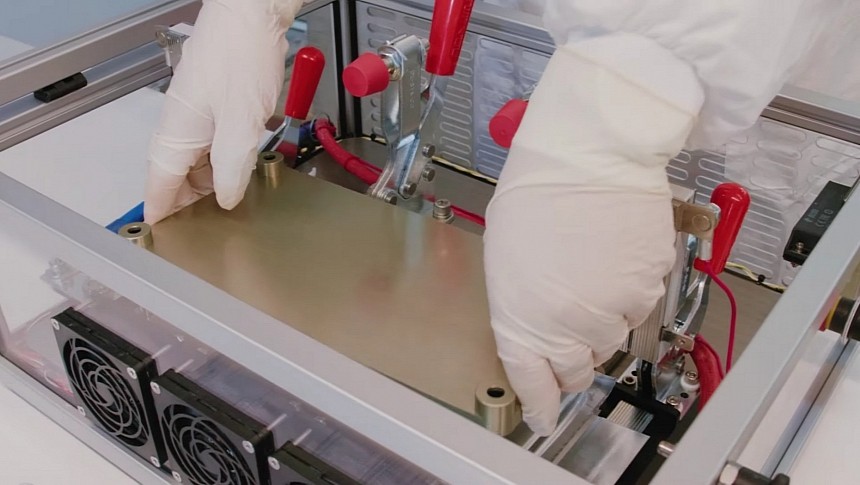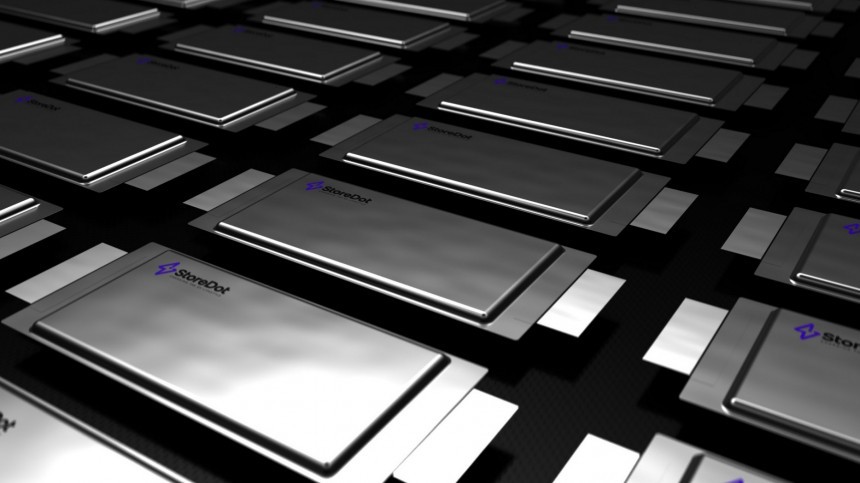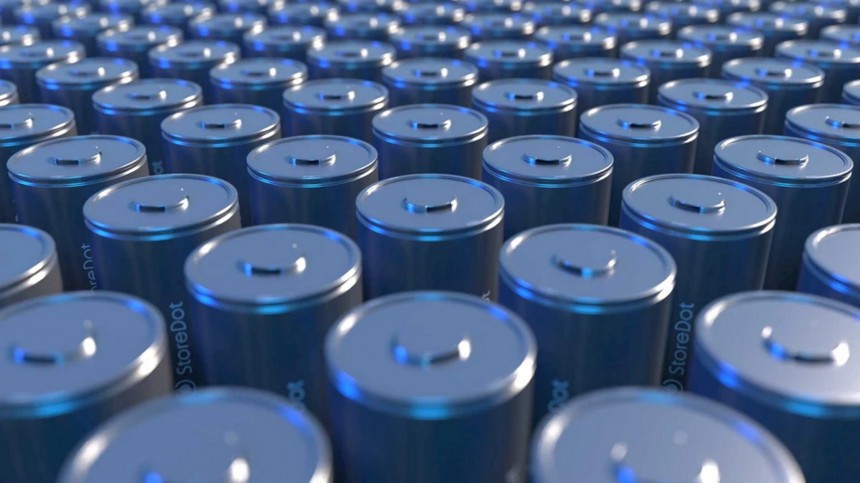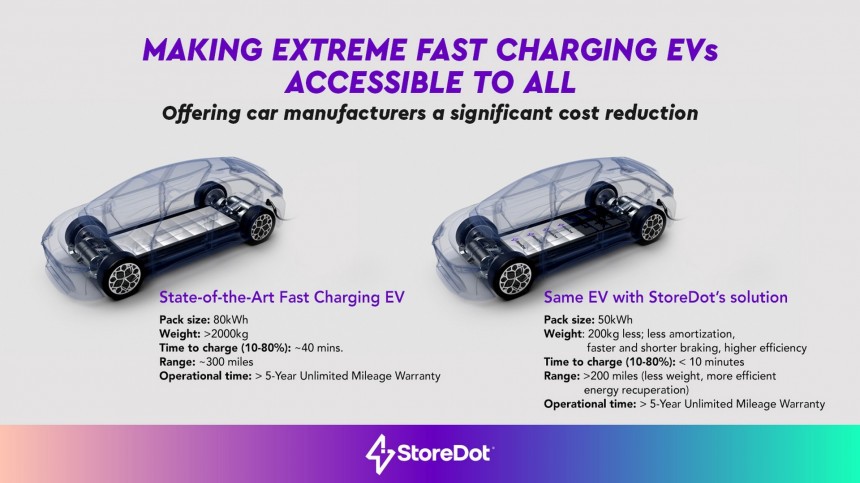After QuantumScape revealed its cells beat its commercial targets, StoreDot wanted to share some good news as well. According to the Israeli battery startup, its extreme fast charging (XFC) cells have endured 1,000 cycles of fast charging without presenting any degradation. The results were similar with another 1,000 cycles in slow charging.
That's a better result than those QuantuScape presented. The solid-state platform startup said its cells retained 95% charging capacity after 1,000 cycles. StoreDot initially said its XFC batteries submitted to fast charging did not show any additional degradation when compared to cells charged more slowly. In other words, both conditions would impose the same penalties. However, the startup did not mention any degradation, which suggests that its 100in5 batteries are as good as new after recovering from 10% to 80% in ten minutes.
The results came from tests the Israeli startup performed. As credible as its numbers have proven to be, this means that we should probably wait for independent tests to be sure that its cells are as good as this new evaluation suggests.
The 1,000 cycles were not obtained in the same fashion as QuantumScape's. A wholly discharged XFC cell was submitted to charging at 1C until it reached a 10% state of charge (SoC). That means it took six minutes for the battery to get there. From that point on, it took ten minutes to reach 80% SoC. Going from 80% to 100% demanded 12 minutes more, also under 1C.
That means the XFC cell took 28 minutes to go from 0 to 100%, which is more than 2C (a full charge in 30 minutes). The same battery would then be completely discharged, but StoreDot did not say how much time it took to get back to zero and repeat that test procedure 999 times more. What the company wanted to prove was that its cells are highly robust.
Hopefully, StoreDot will keep performing these tests for many cycles more to discover at which point any degradation occurs. Suppose it stands 2,000 or 3,000 cycles without degradation. That will deliver a genuinely million-mile or million-kilometer battery pack, one that will not need to be replaced for as much as all the rest of the car can still be driven. In other words, the battery pack would not be a concern if external elements did not affect it.
The Israeli startup may soon decide to disclose perforation tests to demonstrate how its XFC cells behave if they hit debris on the road, for example. Another concern relates to aging. How much time will these 100in5 cells resist? If they die after ten years, they will still demand a replacement. I have no idea how battery companies can simulate time or even if they have that concern. In case they don't, they should.
That's because battery pack replacement needs to be discussed, especially if the lifespan is just ten years or not much longer than that. That means that vehicles with no emissions other than tire dust will have to be replaced much sooner than ICE vehicles do because their main components will cost more than they do. That will create a waste problem that will mean we will just be swapping carbon emissions for another concern.
Swappable battery packs with StoreDot's technology could solve that kind of worry and let the battery swapping station operators – and actual owners of these components – much more at ease with their investments. However, it still needs to be confirmed if there is truly no degradation or if it is just much lower than what we see with current lithium-ion cells.
In the end, we are moving fast in presenting cells that can endure fast charging with little or no degradation and discussing very little about costs. It is as if we first had to figure out something that can be charged swiftly and had to worry later about how to make it affordable. What if the prices cannot be reduced?
Compared to QuantumScape's solid-state cells, XFC batteries still have one disadvantage: weight. After all, StoreDot's technology is based on silicon anodes, while the American solid-state platform startup has anodeless cells: a lithium metal sheet forms on the other side of its ceramic separator and plays the role of an anode. We may have vehicles with the same capacity as current ones with only a fraction of their mass. As exciting as that sounds, the price is still the main challenge for both solutions.
Volvo, Polestar (Geely), and VinFast are the leading investors in the Israeli startup, so the first car with 100in5 cells should come from one of these brands. StoreDot said that should happen in 2024, even if Polestar has already disclosed that it expects to sell its first vehicle with XFC cells in 2026. It should not take long for us to discover which company will introduce this new battery tech to the market.
The results came from tests the Israeli startup performed. As credible as its numbers have proven to be, this means that we should probably wait for independent tests to be sure that its cells are as good as this new evaluation suggests.
The 1,000 cycles were not obtained in the same fashion as QuantumScape's. A wholly discharged XFC cell was submitted to charging at 1C until it reached a 10% state of charge (SoC). That means it took six minutes for the battery to get there. From that point on, it took ten minutes to reach 80% SoC. Going from 80% to 100% demanded 12 minutes more, also under 1C.
Hopefully, StoreDot will keep performing these tests for many cycles more to discover at which point any degradation occurs. Suppose it stands 2,000 or 3,000 cycles without degradation. That will deliver a genuinely million-mile or million-kilometer battery pack, one that will not need to be replaced for as much as all the rest of the car can still be driven. In other words, the battery pack would not be a concern if external elements did not affect it.
The Israeli startup may soon decide to disclose perforation tests to demonstrate how its XFC cells behave if they hit debris on the road, for example. Another concern relates to aging. How much time will these 100in5 cells resist? If they die after ten years, they will still demand a replacement. I have no idea how battery companies can simulate time or even if they have that concern. In case they don't, they should.
Swappable battery packs with StoreDot's technology could solve that kind of worry and let the battery swapping station operators – and actual owners of these components – much more at ease with their investments. However, it still needs to be confirmed if there is truly no degradation or if it is just much lower than what we see with current lithium-ion cells.
In the end, we are moving fast in presenting cells that can endure fast charging with little or no degradation and discussing very little about costs. It is as if we first had to figure out something that can be charged swiftly and had to worry later about how to make it affordable. What if the prices cannot be reduced?
Volvo, Polestar (Geely), and VinFast are the leading investors in the Israeli startup, so the first car with 100in5 cells should come from one of these brands. StoreDot said that should happen in 2024, even if Polestar has already disclosed that it expects to sell its first vehicle with XFC cells in 2026. It should not take long for us to discover which company will introduce this new battery tech to the market.























